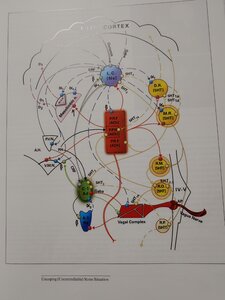There isn't a fixed number of frequencies like that, though, and our perception of pitch is not linear, it's logarithmic. So the pitch difference between 1,000 Hz and 2,000 Hz is the same as the pitch difference between 4,000 Hz and 8,000 Hz. Nonetheless, a doubling of pitch is still kind of a large jump; when you play a note on a piano and then play the next higher note (including all keys, black and white), the increase in pitch is about 6%.
That's so awesome - I have always had a fascination with basic music theory.
Even though I know what your talking about - it never clicked for me until you pointed that out.
I have been a self-taught guitarist since 1981 and enjoy studying college music theory text books.
For those who do not yet have a basic understanding of Sound Frequency.
What follows is a basic example of the use of the Helmholtz frequency system -
And I guess how humans perceive pitch - but I don't want to get too crazy here.
The easiest way that I know is to use the Chromatic Musical Scale and the Grand Piano keyboard as references.
I'm going to play teacher's pet now and hopefully get a gold star.
The keyboard of the Grand Piano has 88 keys.
The notes of the keys repeat themselves every 12 keys:
A1, A#, B, C, C#, D, D#, E, F, F#, G, G#, / A2, A#, B, C, C#, etc...
Each time the set of notes (or Octave) repeat the musical tones get higher in pitch as the frequencies increase.
The first key on a Grand Piano (furthest left) produces the note "A2" (55 Hz).
1st Key / "A2" (55 Hz).
13th Key / "A3" (110 Hz).
25th Key / "A4" (220 Hz).
37th Key / "A5" (440 Hz).
49th Key / "A6" (880 Hz).
61st Key / "A7" (1600 Hz).
73rd Key / "A8" (3200 Hz).
85th Key / "A9" (6400 Hz).
88th Key / "C9" (8372 Hz).
(Beyond the Grand Piano):
"A10" (12,800 Hz).
"C10" (16,700 Hz).
So to test the human ear using every "musical note" between 55 Hz and 16,700 Hz - We would only have to suffer through 120 test tones and NOT the 16,000 I first proposed - due to logarithmic nature of the Helmholtz frequency system and the non-linear way humans perceive pitch.
To just test from 12,800 Hz to 16,700 Hz would only take the span of 4 adjacent musical notes - A10, A#10, B10, C10.
To turn a standard test into an extended test (6,400 Hz to 16,700 Hz) would only take an extra 16 test tones using this example.

 Member
Member
